Hagia Sophia was built in 537 CE, already then with its impressive dome that was damaged in 557 in an earthquake, and in the next almost thousand years, as an important Christian centre, it was repaired and had additions built with new mosaic decorations put in, but it was also the object of Christian, Crusaders’ (!!!) plundering. Still, it managed to survive all of that and in 1453 when Mehmed II the Conqueror finally took Istanbul over it was turned into a mosque, with new repairs and additions, and with time it also had four minarets added to it. When I say that Istanbul was “finally” taken over in 1453 this is because it is important to have in mind that the Battle of Kosovo was in 1389 and Serbia is significantly more to the west in relation to the then Constantinople. Taking into consideration that the Ottomans came from the east, they obviously for their west-bound advancement used the Dardanelles strait that connects the Sea of Marmara and the Mediterranean Sea, first expanding throughout the Balkans, while apparently leaving Constantinople until later.
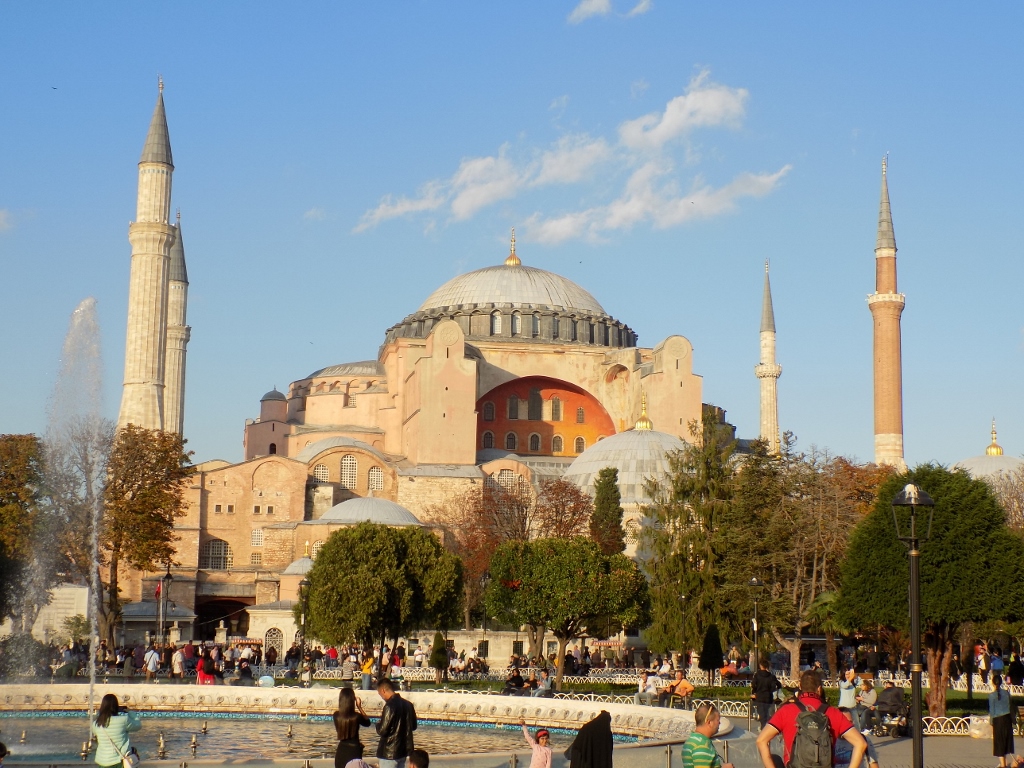 Hagia Sophia in the afternoon sun
Hagia Sophia in the afternoon sun
And then, since 1935 Hagia Sophia has been functioning as a museum and thus it may be visited when the museums are open, which meant that we reached its entrance a little before 9 am and as I’ve said in my previous text we bought the 5-day Museum Pass and used it immediately to visit the museum – former mosque – former church.
What is striking as soon as one enters the central space of the building is its size. The building is certainly big from the outside as well, but it is only when you enter it and see how its interior space is organised that you really start to get the idea about its impressiveness. I believe that the construction concept and the possibility of building such an enormous structure are quite clear to architects, civil and structural engineers, and others who are experts for the subject. To me and I believe to other laymen, the breathing simply stops when you face this grandiose interior space. To build an edifice of this size would, even today, with all of the technology, knowledge and contemporary machinery, be quite an awe-inspiring endeavour, but to make something like that back in the 6th century, in only five years, is absolutely at the level of a miracle. This is precisely used in different comments and chronicles that have reached our times where it is emphasised that this building does not actually belong to this plane of existence, but rather that it could be created only directly thanks to God, his messengers and His Holy Wisdom, i.e., to Saint Sophia.
But, when the first impressions and the state of being taken aback by the monumentality subside a little, then one can take the time and start to walk around and look at different details.
To start with, it is important to take note of the central door used to pass from the esonarthex into the naos. The door is called the Imperial Door, since originally only emperors were allowed to use it for entering the church and above this door there is an exquisitely beautiful mosaic of Christ Pantocrator.
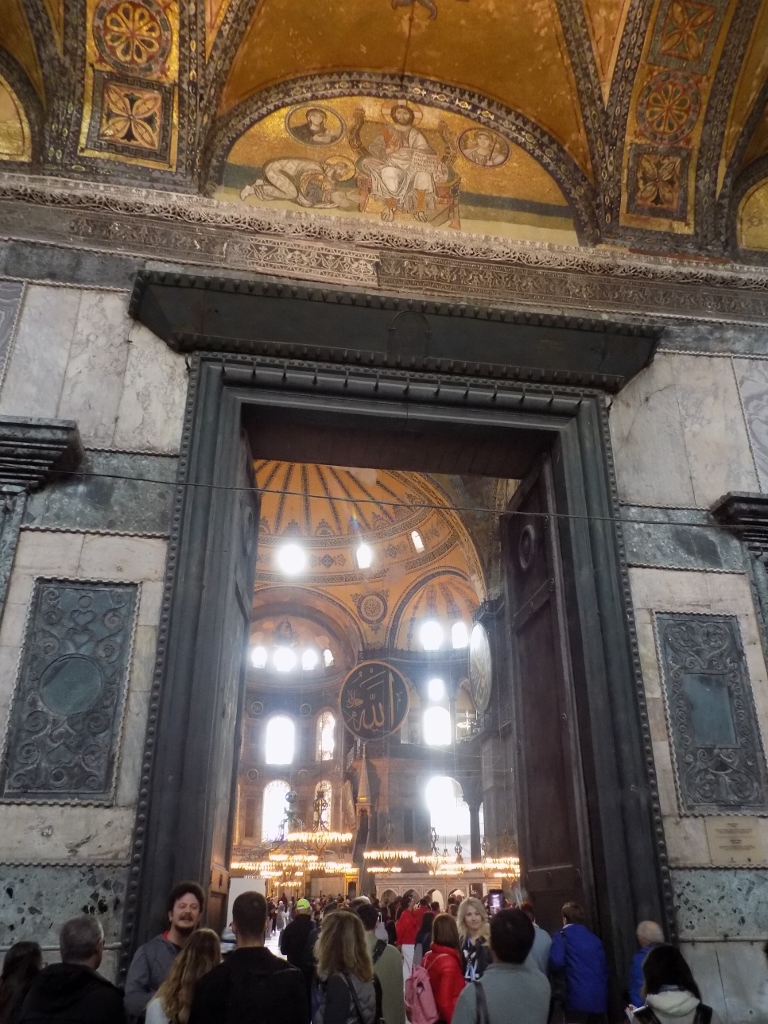 Hagia Sophia, Imperial Door through which it is possible to see the naos, and the mosaic of Christ Pantocrator
Hagia Sophia, Imperial Door through which it is possible to see the naos, and the mosaic of Christ Pantocrator
When we were visiting Hagia Sophia, the left side of the naos was covered in scaffolds, which partially spoiled the impressions and certainly any photographs touching upon that side, but not significantly. We immediately headed for the apse in which, when the church was turned into a mosque, new users placed a mihrab (a niche at a mosque marking the direction of Mecca) and a minbar (practically a Muslim version of a pulpit, i.e., the place from which the imam leads a prayer). Around the middle of the 19th century, huge medallions were placed on the tops of the columns carrying the roof structure. These medallions contain names of the Allah, Muhammad, and the four caliphs, as well as two grandsons of Muhammad, written in the Calligraphic script. The gilded inscriptions were made by a famous calligrapher, while the diameter of the medallions is staggering 7.5 m, which makes them the biggest in the Islamic world. When Hagia Sophia became a museum, everything was nicely left in its place, on top of which they also revealed Christian mosaics, so today it is possible to enjoy this divine amalgamation of history, cultures, religions and remarkable artistic creations. After all, as is the case throughout Istanbul.
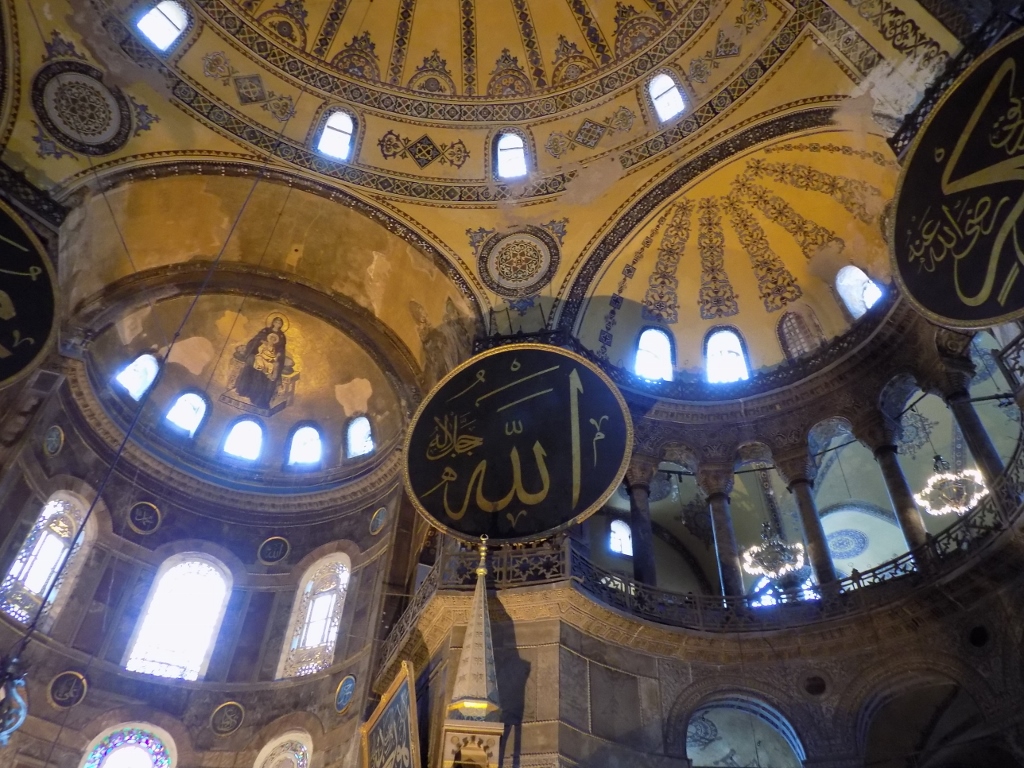 Hagia Sophia, the apse is to the left, while in the middle there is a medallion above the minbar
Hagia Sophia, the apse is to the left, while in the middle there is a medallion above the minbar
In the semi-dome that tops the apse, it is possible to see the mosaic of the Virgin with Child made in the 9th century.
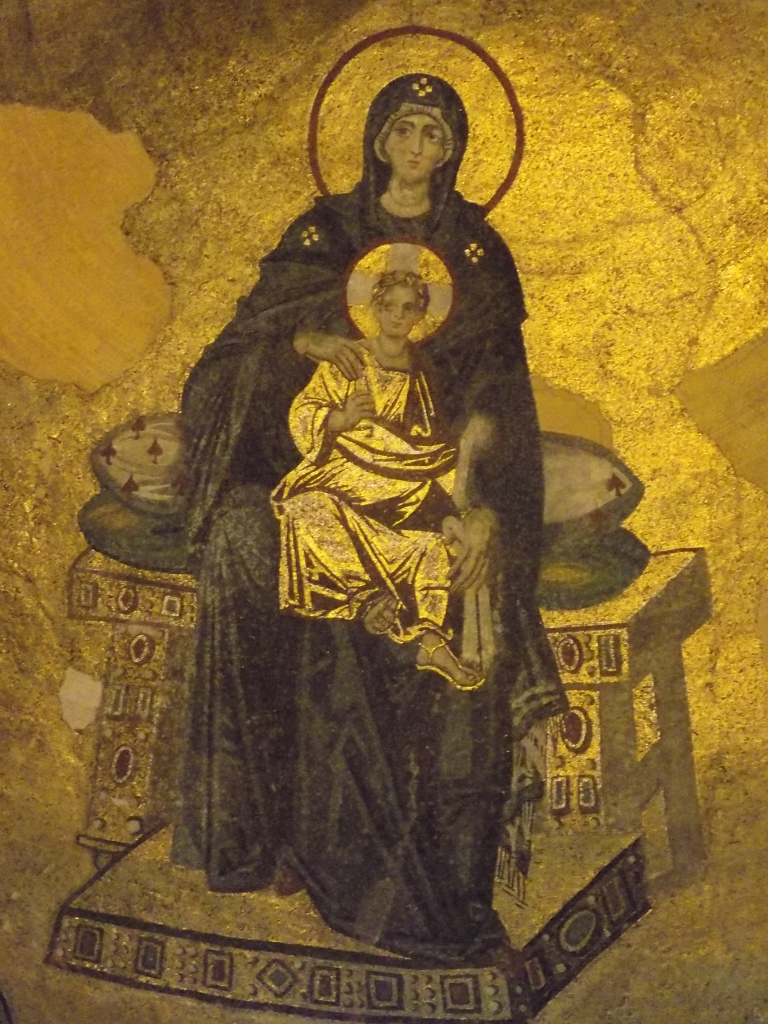 Hagia Sophia, mosaic of the Virgin with Child
Hagia Sophia, mosaic of the Virgin with Child
After looking at the apse, we started going around, thus visiting the interior of the space. In the period when Hagia Sophia served as a mosque, in a side section a library-reading room of Sultan Mahmud I was made in 1739.
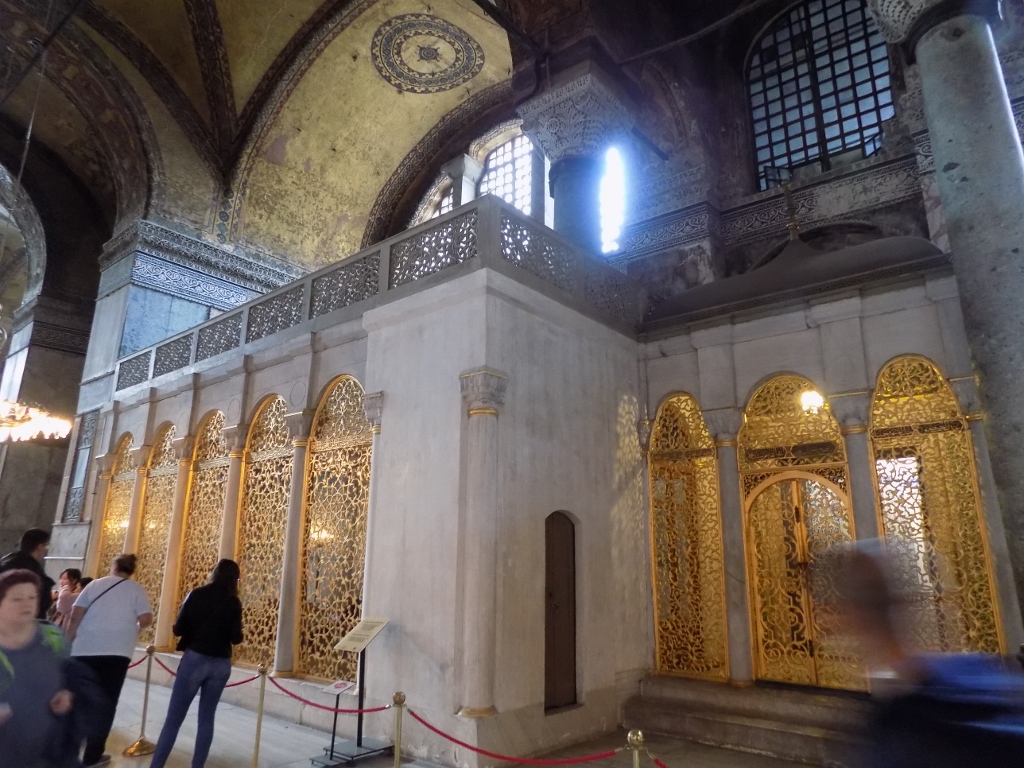 Hagia Sophia, library-reading room of Sultan Mahmud I
Hagia Sophia, library-reading room of Sultan Mahmud I
Then we walked to the corner of the naos that is located to the left from the Imperial door (when you enter the naos through it). To start with, one can again admire the interior space of Hagia Sophia from there, but it is also possible to see the architectural and static organisation of the load-bearing of the roof construction. Not only that there are two rows of pillars that serve this purpose, but also the masons inserted numerous windows into the arched walls in order to ensure natural light within the church. In the next photo, in addition to all of this, it is also possible to see one of the two lustration urns which were in the 4th century BCE each made of a single piece of marble in Pergamon, an ancient city in Asia Minor, and which served for ritual purification, since they can contain around 1250 litres of some “holy water.” They were brought here in the 16th century by Sultan Murad III and then they were used to distribute juices to the faithful during holy days.
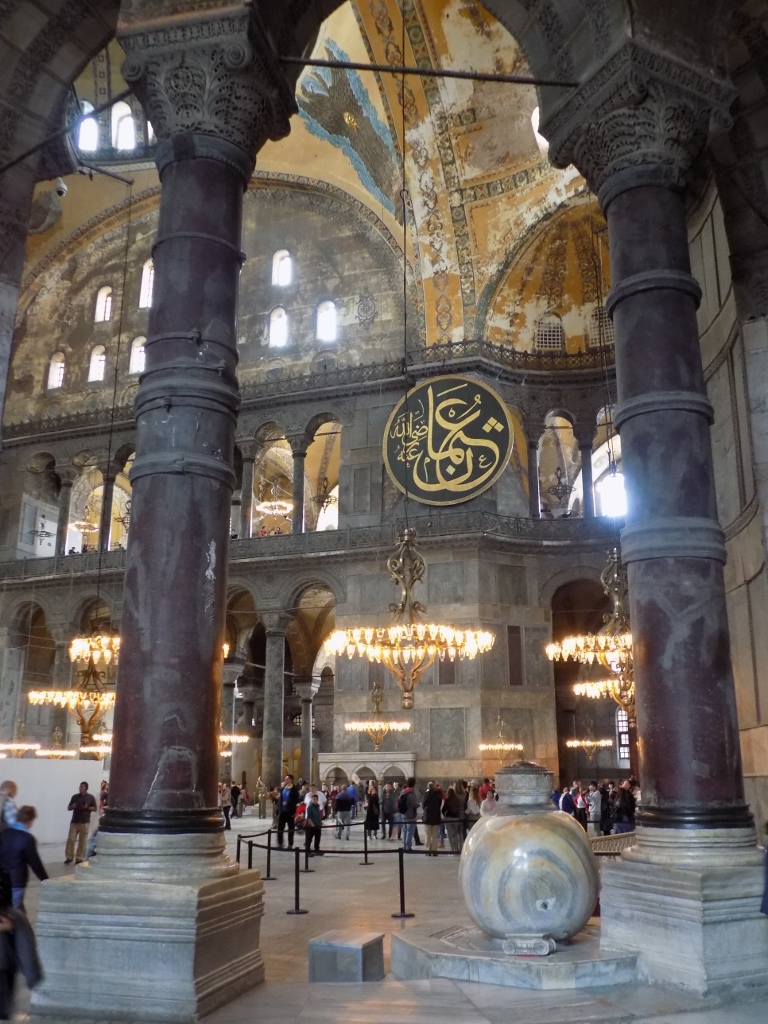 Hagia Sophia, the urn may be seen in the lower right-hand corner
Hagia Sophia, the urn may be seen in the lower right-hand corner
Exactly behind my back, considering the position in which I took the photo above, there is the Wishing Column, although it is often called other names as well. Doesn’t matter. The point is that there is a hole inside of it around which there are bronze sheets. Then you “make a wish” by inserting a thumb into the hole, rotating the rest of the hand by sliding your fingers around the hole. Needless to say, nowadays it is much more important for people to strike a pose while doing this and I did it, too. While trying to appear pretty in the photo, I actually forgot to make a wish. Or perhaps I did make a wish, but I don’t remember and I certainly was not concentrated on the wish, i.e., the essence, but rather on the form. Well, this is what the 21st century does to otherwise normal people!!!
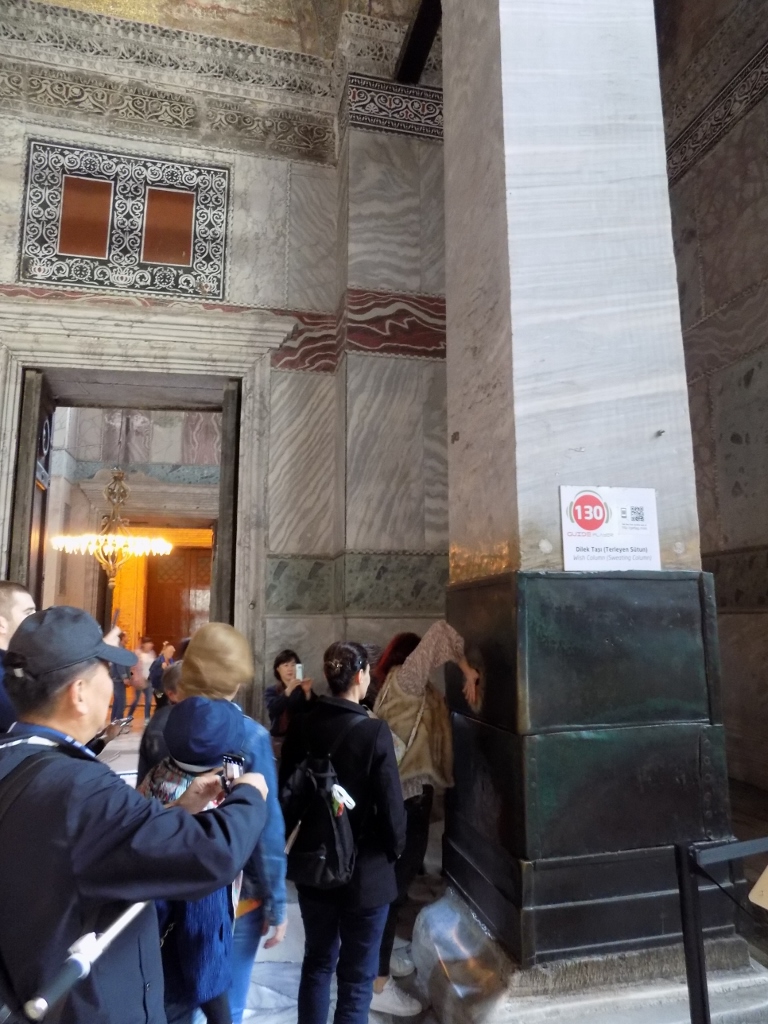 Hagia Sophia, some other woman is currently wishing something dearly
Hagia Sophia, some other woman is currently wishing something dearly
After this we returned to the narthex and from there we went to the upper floor, since there is a gallery there. To start with, we went to the Empress Lodge which is placed directly above the esonarthex and the Imperial Door. During the Eastern Roman Empire, it was from there that the empresses followed the religious service and from this lodge there is yet another striking view at the naos of Hagia Sophia.
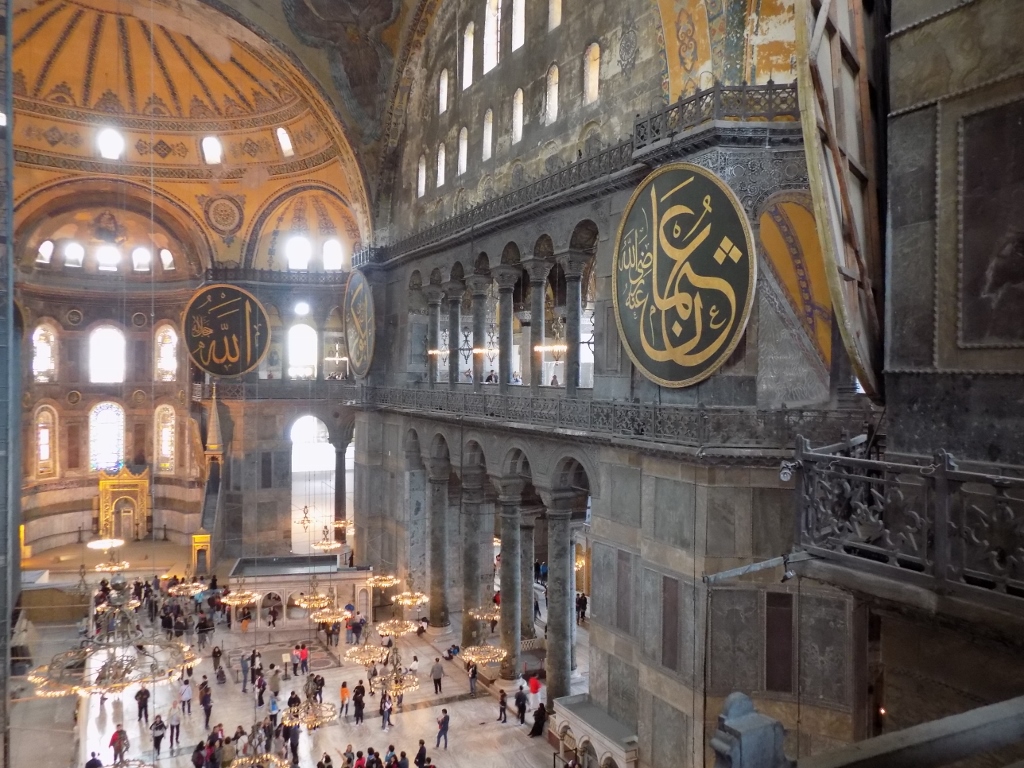 Hagia Sophia, the apse and the south part of the present-day museum (I tried to avoid the scaffolding on the north side)
Hagia Sophia, the apse and the south part of the present-day museum (I tried to avoid the scaffolding on the north side)
The naos of Hagia Sophia has an elongated plan and above the very centre there is that impressive dome with the diameter of around 31 metres, while the height of the crown is around 55.5 m. Then, along the central axis of the naos come two also large semi-domes, one on each side. In the photo above, it is possible to see again the lateral side of the naos with pillars on the ground floor and the gallery, as well as the windows which in addition to bringing harmony and balance and rendering beauty to the otherwise visually heavy and uninteresting wall, also let the sunlight come in. It is precisely in the photo above that it may be seen how the numerous windows in different parts of the building let the light come in and contribute to the general impression of beauty, illumination and the delicateness of the construction of such a large edifice.
Following this enjoying of the view in the place where the Byzantine empresses, I hope, also used to enjoy what they could see, we started with an easy stroll along the gallery that extends from one side of the apse to the other. In this area, in several locations, it is possible to see exceptional mosaics that have survived centuries, conquests, earthquakes and interventions of different types. One of the first we came across was the Deisis mosaic from the 13th century. The mosaic shows Christ in the middle, Mother of God on the left-hand side and John the Baptist on the right-hand side, but my photo in this case shows only Christ.
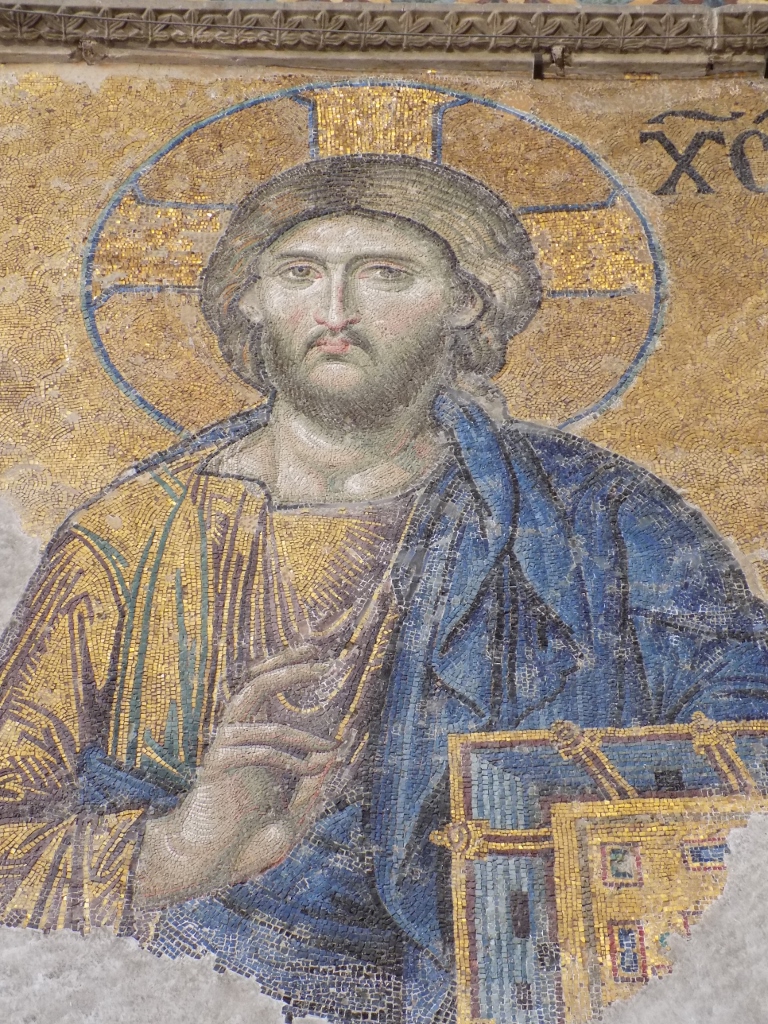 Hagia Sophia, a detail of the Deisis mosaic
Hagia Sophia, a detail of the Deisis mosaic
Walking along the gallery, I kept admiring the interior space of the building with a myriad of details that are there. Needless to say, the scaffolding assembled in the museum is not there in vain. There are many parts of Hagia Sophia that need to be restored and this is done in stages. In the following photo it is possible to see numerous damages on the large west semi-dome and smaller domes and arches above the front section of the naos, but it is also possible to see the position of the Empress Lodge above the Imperial Door.
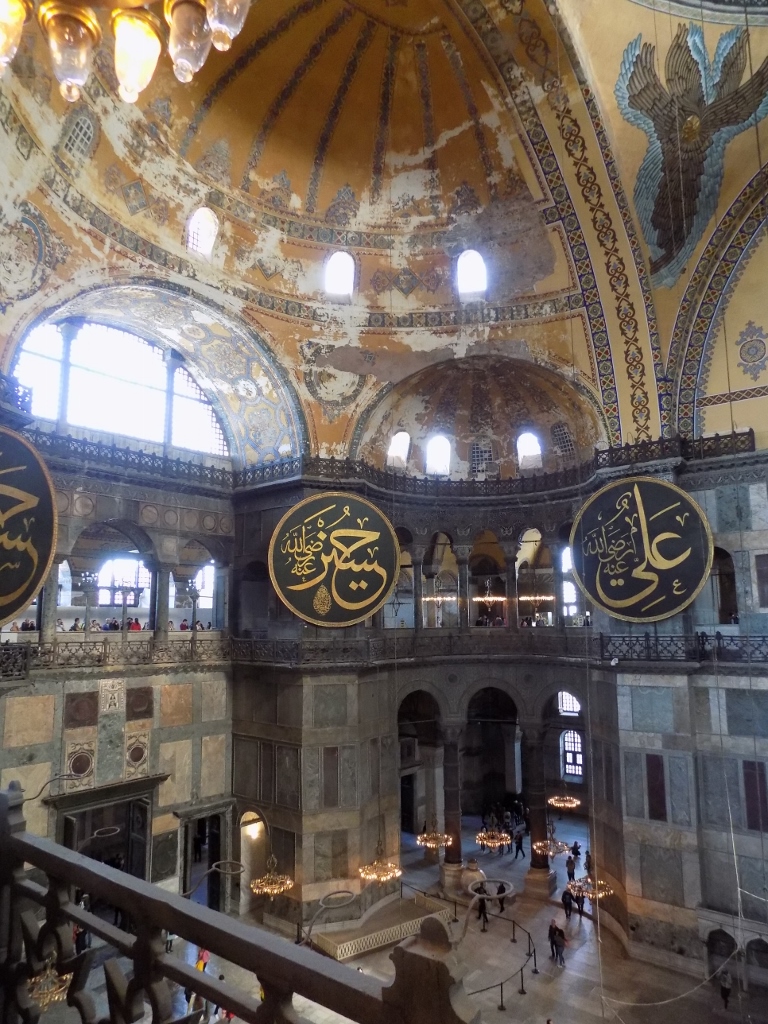 Hagia Sophia: the Empress Lodge and the Imperial Door are on the left-hand side
Hagia Sophia: the Empress Lodge and the Imperial Door are on the left-hand side
One of the details are certainly the pillars with differently made capitals and the impressive mosaics that adorn arches connecting these pillars and they all serve not only to carry the structure, but they also play a very important decorative role.
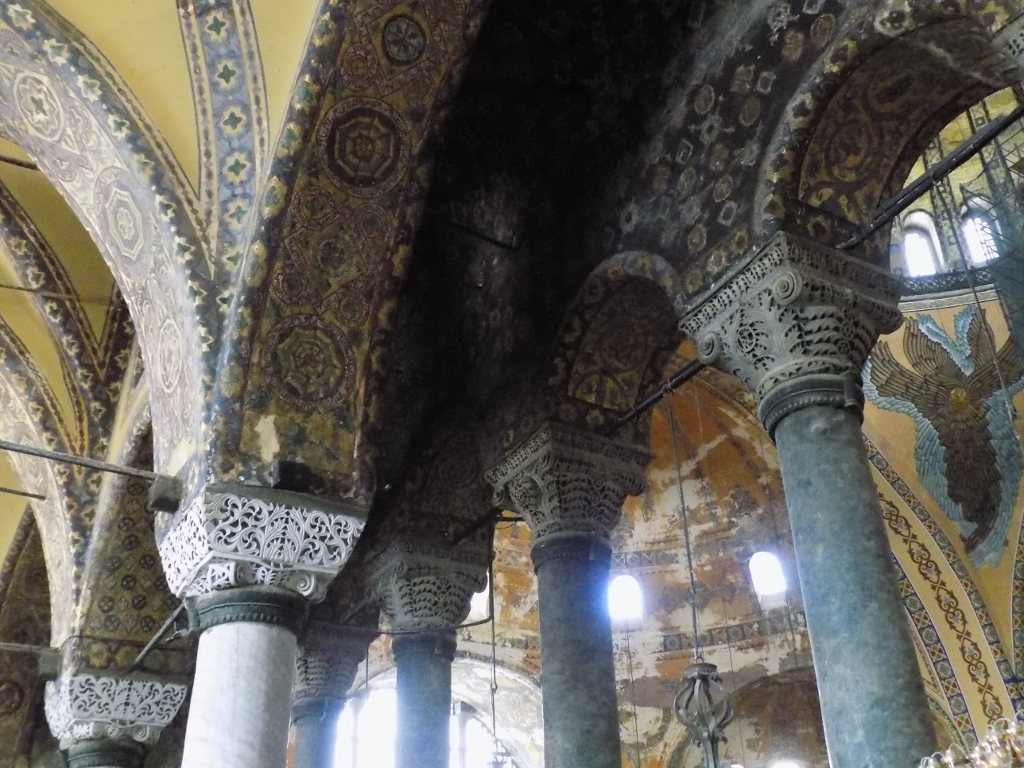 Hagia Sophia: Capitals on the top of the pillars and the mosaic-decorated arches
Hagia Sophia: Capitals on the top of the pillars and the mosaic-decorated arches
When you get to one end of the gallery, it is possible to see an outstanding mosaic composition from the 12th century. In the centre, there is the Virgin with Christ on her lap, while on her right-hand side there is Emperor John II Komnenos and on her left-hand side there is Empress Irene, as well as their son Alexios. The mosaic shows the imperial couple presenting gifts to the Mother of God and Christ.
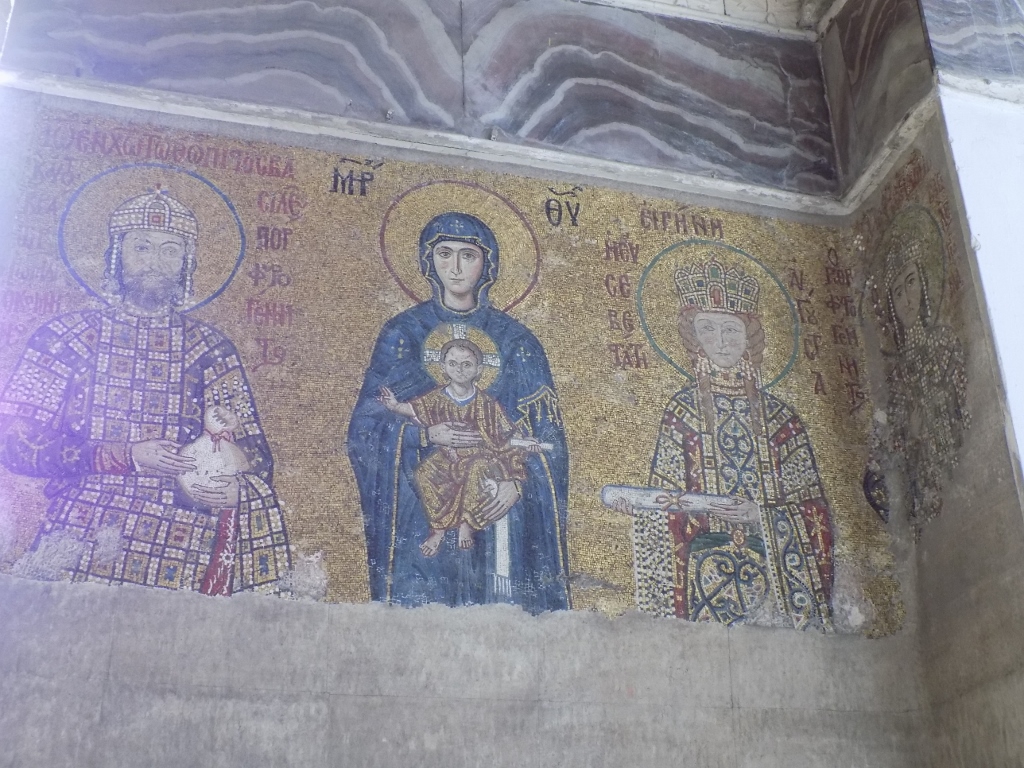 Hagia Sophia: 12th-century mosaic
Hagia Sophia: 12th-century mosaic
When you finally move your gaze away from the mosaic shown in the photo above, from the gallery you can enjoy again the beauty of the interior space of Hagia Sophia.
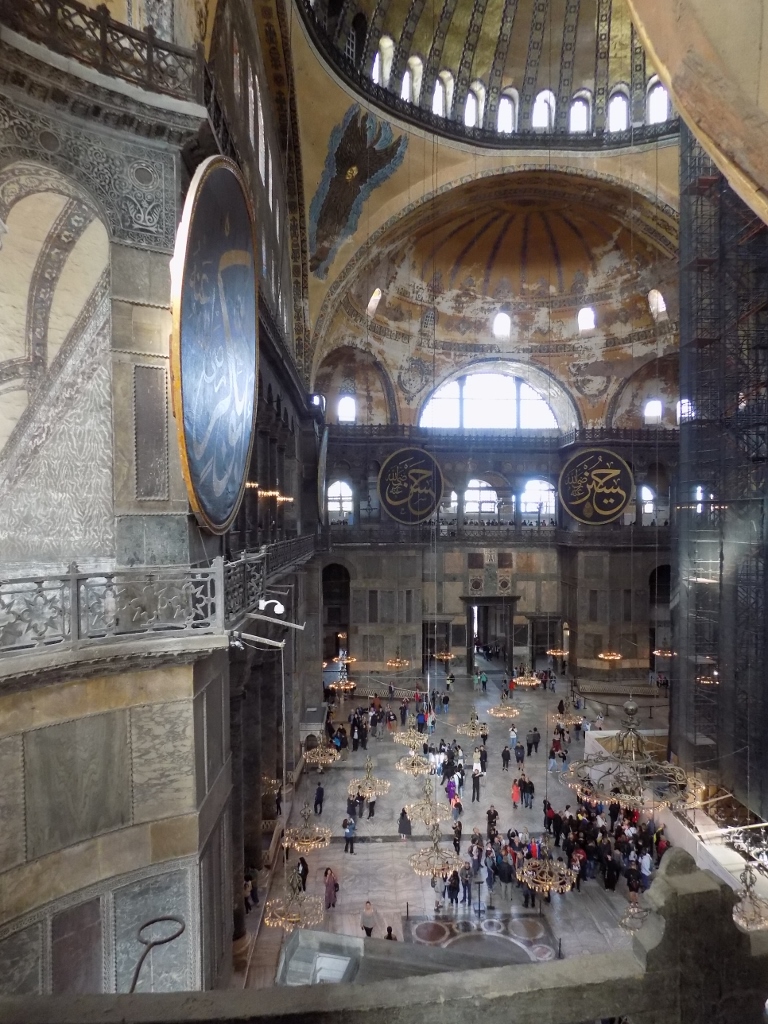 Hagia Sophia: View at the naos
Hagia Sophia: View at the naos
From here we started to return towards the Empress Lodge and went further in circle where along the way we saw a few other interesting mosaics. This was also the way to descend to the ground floor of the present-day museum space.
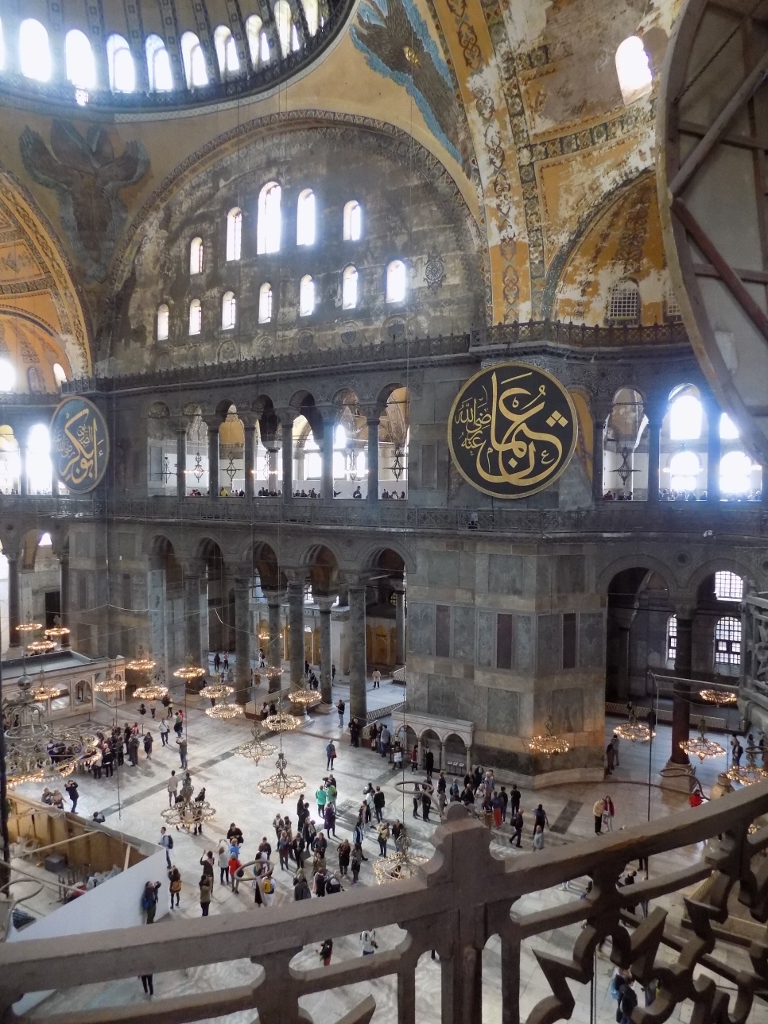 Hagia Sophia: One more view at the naos from the gallery
Hagia Sophia: One more view at the naos from the gallery
I feel the need to emphasise that in Hagia Sophia, after all like in some other places Sneža and I were yet to visit in Istanbul, there are many more details which a visitor may enjoy in comparison to what I’m mentioning here, but it is up to each visitor to look for what specifically interests them.
In any case, in order to exit from Hagia Sophia, one needs to go along the esonarthex and then there are the so-called Beautiful Doors through which one enters a passage that leads outside. In addition to looking more attentively at the doors themselves, it is important that the visitor turns around once the doors are passed, since there is yet another very pretty mosaic above them.
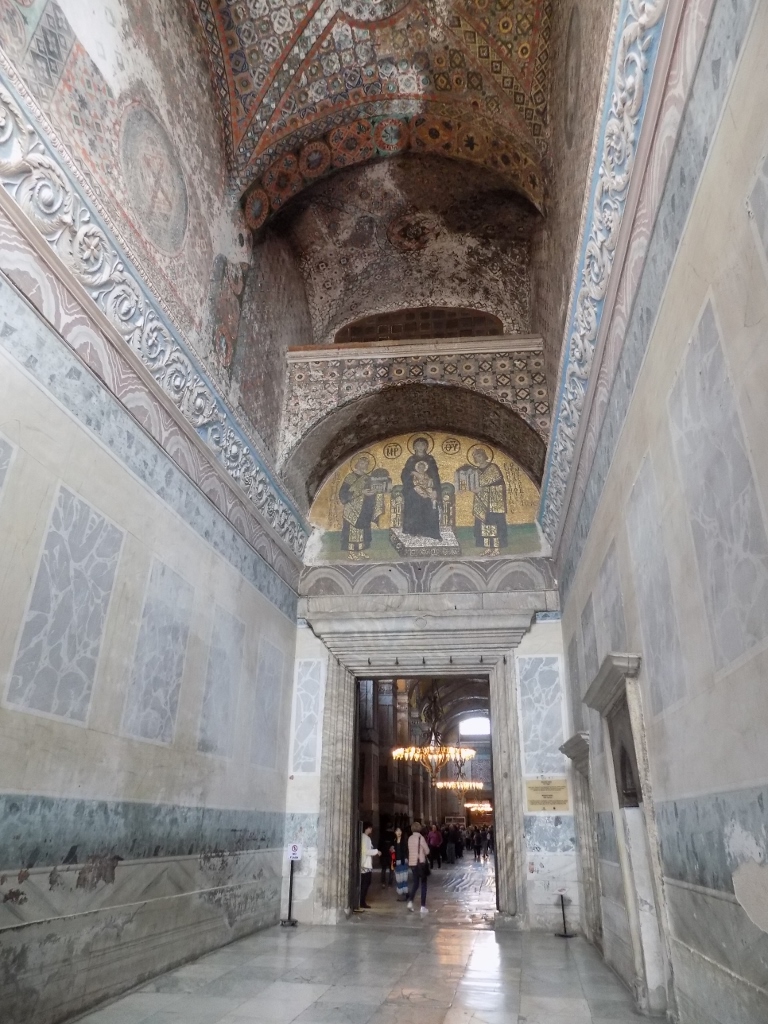 Hagia Sophia: Passage leading from esonarthex (the Beautiful Doors are open and cannot be seen in this photo)
Hagia Sophia: Passage leading from esonarthex (the Beautiful Doors are open and cannot be seen in this photo)
This is a mosaic panel from the 10th century and it depicts Virgin Mary holding Christ on her lap. To her left there is Emperor Constantine who is presenting the model of the city to her, while to her right there is Emperor Justinian who is presenting the model of Hagia Sophia.
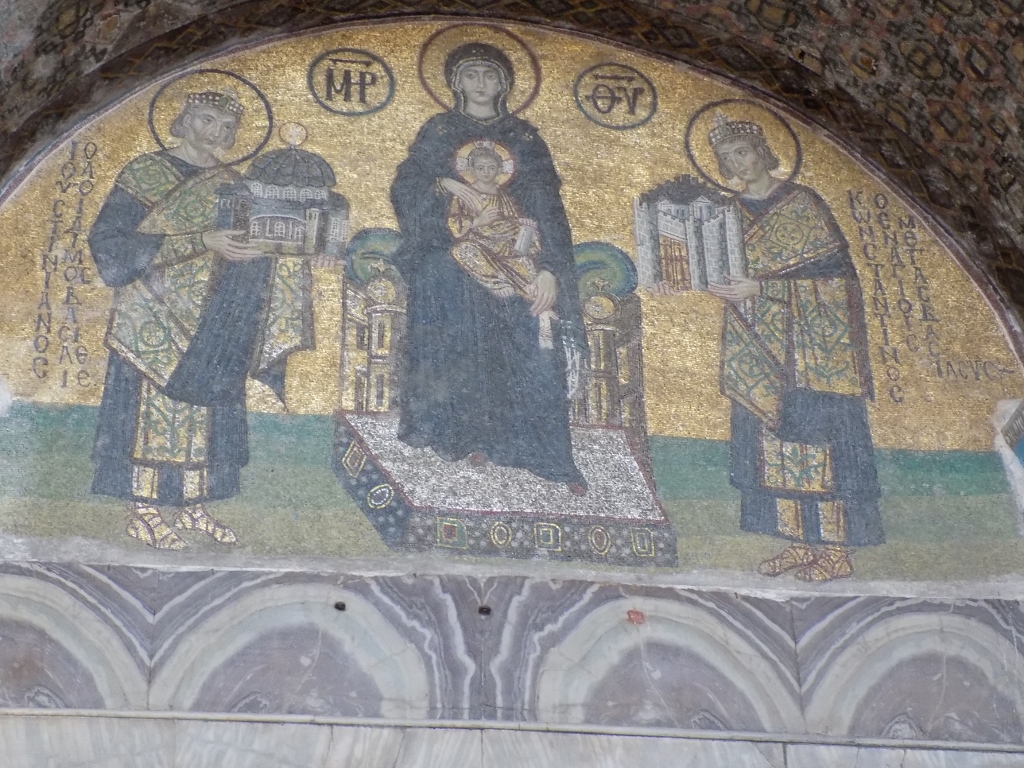 Hagia Sophia: the mosaic panel above the Beautiful Doors
Hagia Sophia: the mosaic panel above the Beautiful Doors
Practically we finished with our sightseeing of Hagia Sophia here, along with some additional minor visits to some places we found interesting, and then we went out in the street and walked to the First Courtyard of the Topkapi Palace, the so-called the Courtyard of the Janissaries. Today, this courtyard is mostly filled with greenery, but there is also Hagia Irene, that is, Saint Eirene, i.e., a church dedicated to the Holy Peace. It is interesting that this church has not been turned into a mosque, but this is only because it was used as an arsenal, i.e., as a warehouse for ammunition.
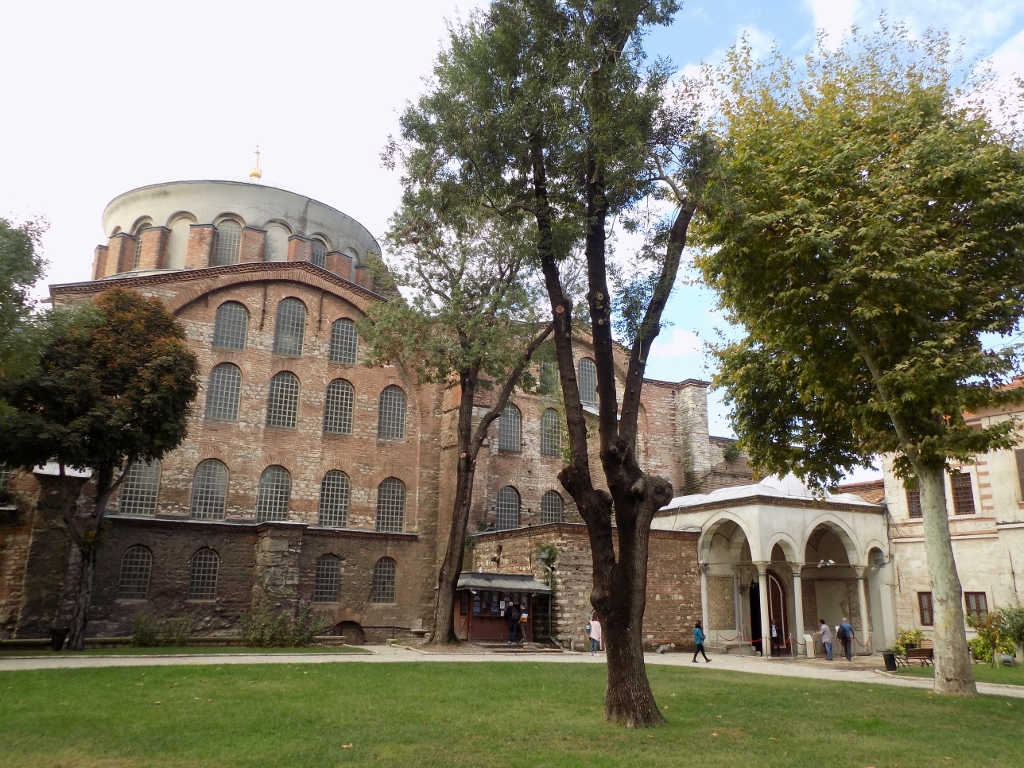 Hagia Irene
Hagia Irene
Nowadays, this former church is a museum space and it is also used for holding concerts on account of its exceptional acoustics.
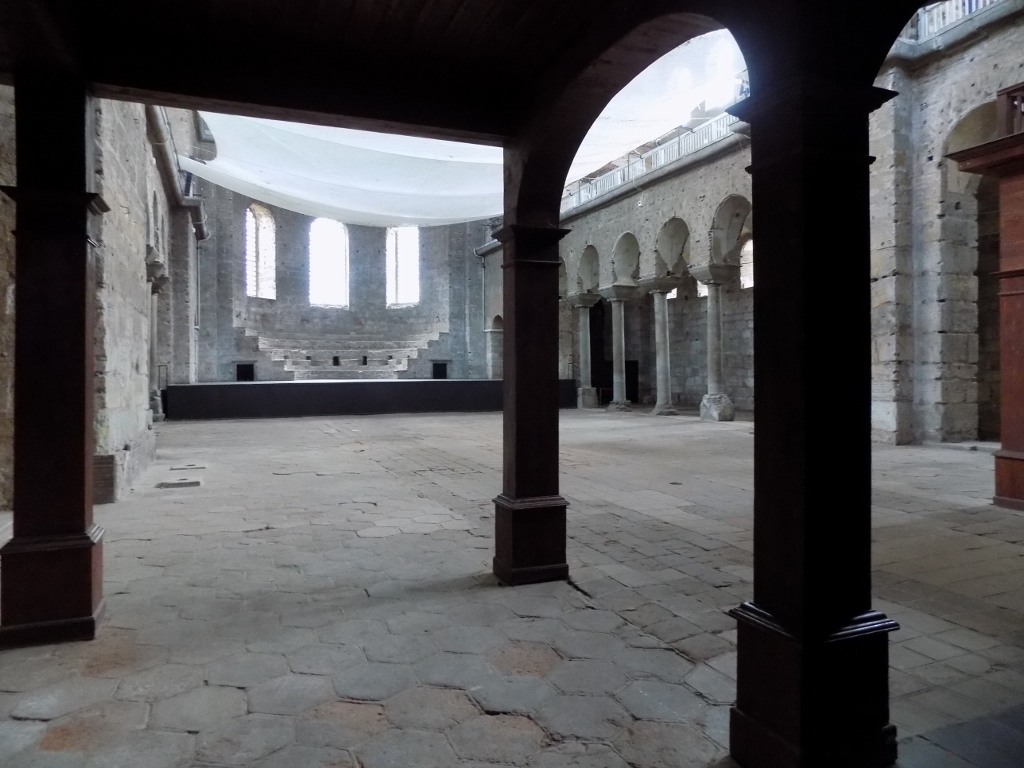 Hagia Irene, the interior
Hagia Irene, the interior
When we went there, the whole naos was protected by some white dense net and it was possible to see that some minor debris was gathering in the net. I’m not sure whether the problem are the birds that fly in through windows and spend their time within the space, but the appearance was certainly quite specific.
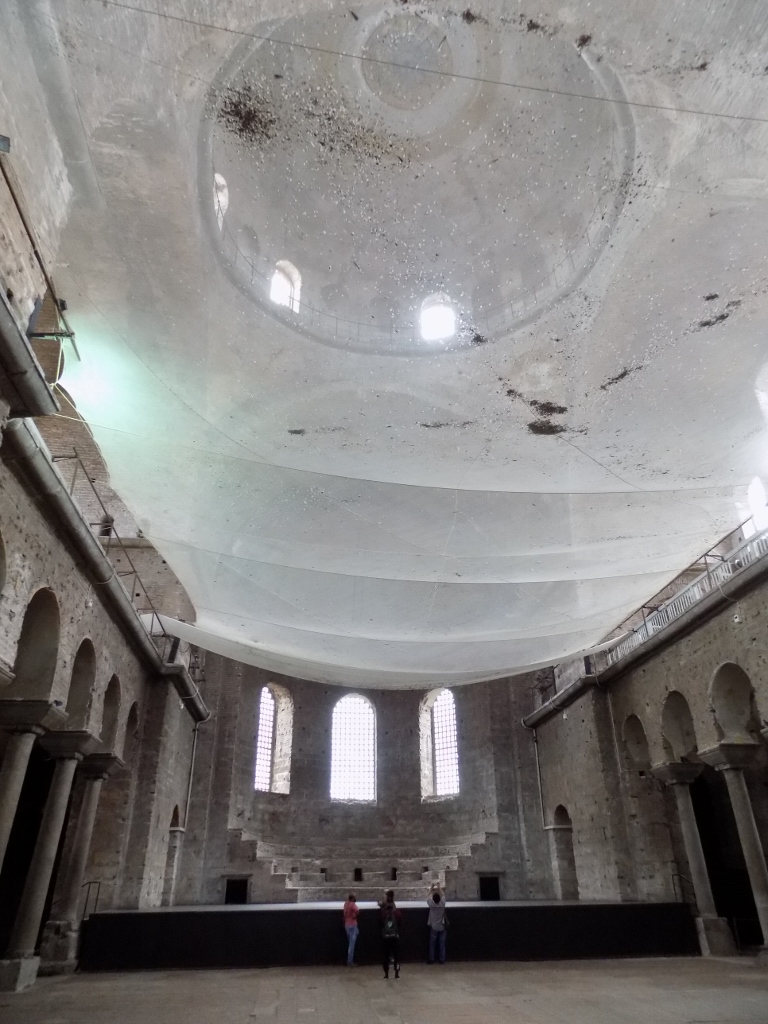 Hagia Irene, the interior: view towards the former altar space
Hagia Irene, the interior: view towards the former altar space
In terms of architecture, this church is interesting, together with Hagia Sophia and Kucuk Hagia Sophia (former Church of Sts. Sergius and Bacchus), on account of the way in which the central dome and the rest of the space are brought together. But, even without this, I found this church rather interesting because of the gradual arrangement of the space of the apse, that may be seen in the photo above, as well as because of the wooden gallery that is located in the front section of the naos.
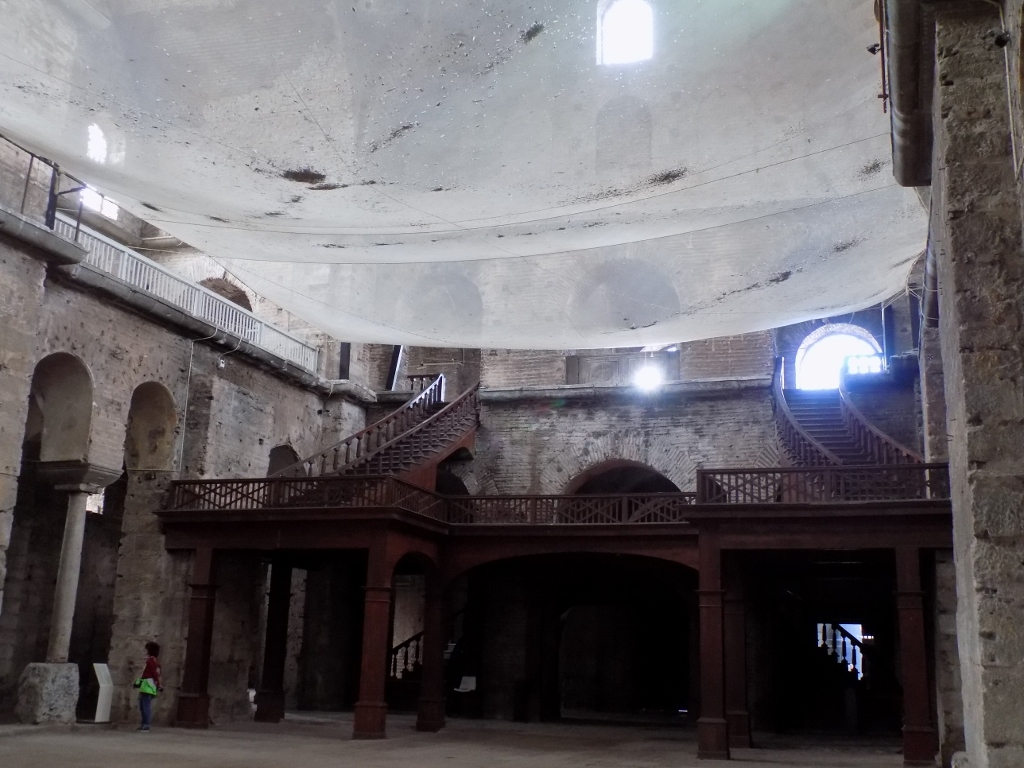 Hagia Irene, the interior: the wooden gallery in the front section of the naos
Hagia Irene, the interior: the wooden gallery in the front section of the naos
We walked around Hagia Irene a little bit more, looking at some other parts and details, and then we returned to the courtyard since the next thing in our plan was a visit to the Topkapi Palace.